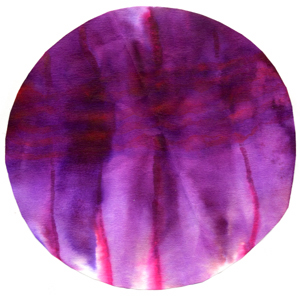Chad and Rob have already noted this piece of news about soon-to-be-published research indicating that the order in which high school students are taught physics, chemistry, and biology makes very little difference to their performance in science classes at the college level, while a rigorous math curriculum in high school gives their college science performance a significant boost.
I have a few things to say about this.
Category Archives: Chemistry
Fun with paper chromatography.

During one of our recent visits to The Tech Museum, we ran across a fun hands-on activity. The pretty purplish circle pictured here is what the younger Free-Ride offspring produced in this activity.
The kids thought they were just doing an art project. But there’s science in that art.
The art project works using the same principles as a time-honored separation technique called paper chromatography. In this post, I’ll lay out some ways you can play with paper chromatography at home, and I’ll point you toward the scientific principles at work underlying the behavior of the materials you’ll be playing with.
Basic concepts: refrigeration.
My last post for the basic concepts series involved phases of matter and transformations from one phase to another. This post will look at how a phase change can be put to practical use in a common household appliance — the freezer. My aim here is to give you a good thermodynamic feel for how a freezer works. As a bonus, I’ll explain why leaving the freezer door open is a futile strategy for cooling down a hot kitchen.
Online source for hands-on chemistry (for kids).
Since Sandra has posted links to sites with brainy games for kids*, and Karmen is working on her list of science education web sites for children, I thought I’d mention one of my favorite online destinations for kid-strength chemistry. Luddite that I am, what I like best is that the site isn’t hypnotizing your child with a virtual chemistry experiment, but actually gives you activities to do with the child in the three-dimensional world.
Science in the courtroom: is ‘made from sugar, so it tastes like sugar’ false advertising?
The July 9 issue of Chemical & Engineering News (alas, behind a paywall — but worth checking to see if your library has an institutional subscription) has an interesting piece [1] on the recently-settled trial in which the makers of Equal (an artificial sweetener based on aspartame) sued the makers of Splenda (an artificial sweetener based on sucralose) over their claim in advertisements, “Splenda is made from sugar, so it tastes like sugar.” The makers of Equal (a company called Merisant) asserted that this claim was deceptive.
Book review: The Ethical Chemist.

People sometimes worry that throwing ethics coursework at scientists-in-training is not such a great strategy for training them to be ethical scientists. (I’ve explored worries of this sort myself.)
For one thing, at many schools the existing coursework may be a fairly broad “moral issues” course aimed at understanding what it means to be a good person rather than a good scientist.* Or the ethics course on the books may have more to do with meta-ethics (the examination of various theoretical frameworks grounding claims about what is good and what is bad) rather than practical ethics. And if the instructor for the course comes from a non-science discipline (like philosophy or religious studies) and is teaching from texts from that discipline, there’s a good chance that the student will ask herself, “What does any of this have to do with being an ethical scientist?”
Chemist Jeffrey Kovac’s book The Ethical Chemist: Professionalism and Ethics in Science is a text that, for those charged with teaching ethics to chemistry students, aims to sidestep these worries.
Basic concepts: phase changes.
Some months ago I made a (seemingly idle) threat to follow up my basic concepts posts on polar and non-polar molecules and intermolecular forces with a post on phase changes. Finally it’s here!
Since the discussion here will be leaning on a number of the concepts discusses in the earlier posts, don’t be afraid to click back to them to re-read any of the parts that seem rusty.
Ka-BOOM! (A few words on fireworks.)
It’s the 4th of July, and here in the U.S., that usually means fireworks.*
What could be better than explosions in pretty colors? Maybe a few details of how firework makers get those colors into the fireworks.
Chem 2.0
The June 25th issue of Chemical & Engineering News has two pieces that talk about ways people are using features of the “new internet” (or Web 2.0) to disseminate and explore chemistry online.
Extra benefit of the growing ‘green chemistry’ movement.
There’s an article in today’s Inside Higher Ed on the building momentum in college chemistry courses to make the labs greener — that is, to reduce the amount of hazardous materials necessary in the required student experiments. What grabbed me about the article is that it looks like the greening of the chem labs may not just be good for the environment — it could be better for student learning, too.
First, consider a chemist’s description of how to revamp laboratory experiments to make them greener. The article quotes Ken Doxsee, a chemistry professor at University of Oregon:
